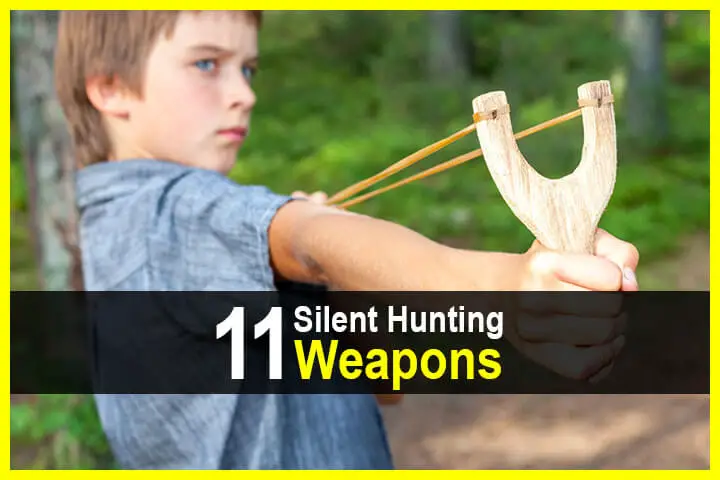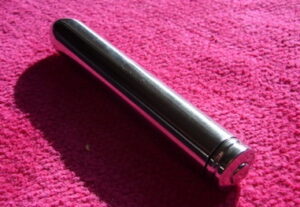Estimated reading time: 13 minutes
Hunting, an ancient yet enduring practice, has played a pivotal role in human survival and evolution. Today, it’s both a recreational activity and a means of wildlife management.
Silent hunting weapons are key to a successful hunt, offering the advantages of stealth, precision, and minimizing disturbance to wildlife.
This article will show you the world of silent hunting weapons, exploring their varied types, functionality, and importance. With these comprehensive insights, you should be able to pull off a successful hunt with the right weapon.
Want to save this post for later? Click Here to Pin It On Pinterest!
Bows

Bows are a quintessential silent hunting weapon, harnessing stored mechanical energy to launch arrows with precision and silence. The bow’s operation principle is straightforward: bending the bow stores energy, which is then transferred to the arrow upon release, propelling it towards the target.
There are three major types of bows: Longbows, Recurve bows, and Compound bows.
Longbows

Longbows are the simplest and oldest, known for their tall, D-shaped design. Longbows provide a smooth draw but require significant strength and skill, potentially limiting their use.
Recurve Bows

Recurve bows are identifiable by their tips curving away from the archer. Recurve bows offer more power in a compact size, making them popular for horseback hunting.
Compound Bows

Compound bows incorporate a system of pulleys. Compound bows deliver high accuracy and power with less physical strain, but their mechanical complexity may present maintenance challenges.
Bows are adept at hunting games from deer to fish, depending on the bow type and arrowhead.
Spears

Spears serve as another silent hunting weapon, widely used in various hunting scenarios due to their versatility, inexpensive construction, and ease of use. From ancient tribes to modern survivalists, the spear has proven its worth as a potent hunting tool. Here are the significant types of spears:
Throwing Spears

Throwing spears are lightweight for easy throwing and often balanced for accuracy. Throwing spears are effective for smaller game or fish, especially in survival situations.
Fishing Spears

Fishing spears are specifically designed for underwater use. Fishing spears have multiple tines to improve chances of hitting a swift-moving target
Spears can be used to hunt a wide range of animals, from fish and waterfowl with multi-pronged fishing spears to larger game like boar and deer with sturdy, sharp-tipped throwing spears. However, spear hunting often requires proximity to the prey, potentially increasing the risk and challenging the hunter’s skill and courage.
Slingshots

A slingshot, another silent hunting weapon, is a compact and lightweight tool that’s often underestimated in its effectiveness. Slingshots offer the advantage of quiet operation, portability, and virtually unlimited ammunition in the form of stones or other small objects. Here are the primary types of slingshots:
Classical Slingshots

Classical slingshots are Y-shaped frames with an elastic band attached. Classical slingshots are ideal for small game hunting and target practice.
Starship Slingshots

Starship slingshots feature a brace against the forearm. Starship slingshots offer more stability, power, and accuracy, making them suitable for larger game.
The effectiveness of a slingshot highly depends on the user’s skill. It’s best suited for hunting small game like rabbits, birds, or squirrels, especially in survival situations where stealth and resource conservation are crucial. Learning to aim and shoot accurately with a slingshot takes practice, but once mastered, it can be a highly rewarding hunting method.
Bolas

Bolas are an ancient hunting weapon developed by indigenous peoples of South America. As a silent hunting tool, they are composed of two or more weights connected by a cord, used to entrap the legs of prey when thrown. Bolas can be incredibly effective, particularly for hunting birds or small mammals.
There are two distinct types of bolas: the Inuit Bolas and the Gauchos Bolas. The Inuit variant, typically made from sinew and bone, is used for bird hunting, exploiting their interconnected design to ensnare birds in flight. The Gauchos variant, crafted from leather and stone or metal, is employed for ground-based hunting, capturing animals by tripping them.
Hunting with bolas is best suited to scenarios where stealth is required, as the weapon’s silent operation can be a significant advantage. They are particularly effective for hunting small game, birds, and in some cases, larger, ground-based prey.
While the use of bolas requires a certain level of skill and practice, it can be an incredibly rewarding method of hunting.
Nets

Nets have been employed as silent hunting tools for hundreds of years, and their versatility and effectiveness remain undeniable. They can be made from various materials such as nylon, cotton, or even natural fibers, and their design can range from simple, single-layer nets to complex, multi-layered systems. This diversity in types makes nets adaptable to different hunting scenarios.
For instance, drift nets are designed to ensnare aquatic animals in water, while gill nets are specialized to trap fish by their gills. Trap nets, on the other hand, are land-based and are commonly used to catch birds or small mammals. Given this variety, the use of nets can be tailored to a host of different prey, from fish to birds and small game.
Nets are especially suitable for situations where silence is crucial or in scenarios where hunting a group of animals is desired. Though it involves a learning curve, hunting with nets can be an incredibly effective and satisfying method.
Traps

Traps occupy a unique position among hunting tools as they operate passively, providing a method of hunting that requires strategic planning and patience. They work by ensnaring or capturing prey that wanders into them, often lured by bait. Traps allow hunters to target specific animals and can be designed to accommodate various hunting scenarios.
For example, snare traps are excellent for catching small game like rabbits. Pitfall traps can be employed for larger animals. Cage traps, on the other hand, are ideal for capturing live animals, and foothold traps are typically used for fur-bearing animals.
Traps can be especially effective in scenarios where the hunter cannot be physically present all the time, allowing for hunting to occur over extended periods. Traps do, however, require a keen understanding of animal behavior and habitats to place effectively.
Blowguns

Blowguns, often underrated, stand as an excellent tool for silent hunting. They operate on the simple principle of using breath to launch a projectile at a target. Despite their simplicity, blowguns provide a thrilling hunting method that particularly shines in scenarios requiring stealth and precision.
There are two main types of blowguns: short blowguns and long blowguns. Short blowguns are typically easier to handle, making them suitable for beginners or use in confined spaces. Long blowguns, on the other hand, offer increased range and accuracy at the expense of portability.
Blowguns are especially effective for hunting small game like birds, squirrels, and rabbits. They can also be used to catch fish and reptiles with special darts. However, the success of blowgun hunting heavily relies on the user’s breath control and aim precision.
For those curious about this ancient hunting method, the following resources provide great insight into the art of blowgun hunting.
Atlatls

Atlatls, also known as spear-throwers, are an ancient hunting tool that uses leverage to achieve greater velocity in dart-throwing. They’re silent, making them ideal for stealth hunting.
The basic atlatl is simple and lightweight, making it easy to handle. From there you can add a banner stone, which is a weight added to it to increase the spear’s speed and distance. Without the weight, the spear will have more control and precision.
For hunting large games like deer and elk, the increased force from a weighted atlatl is beneficial. For smaller game or when precision is paramount, a weightless basic atlatl may be more suitable. These tools require practice to master, but their effectiveness in various hunting scenarios is undeniable.
Crossbows

Crossbows are a silent and lethal hunting weapon, revered for their high power and remarkable precision. They are characterized by their horizontal bow-like assembly mounted on a frame, which is designed to shoot projectiles called bolts or quarrels. Crossbows come in various forms, including recurve crossbows, compound crossbows, and reverse limb crossbows.
Recurve crossbows have longer draw lengths and are known for their simplicity and reliability, while compound crossbows leverage a system of cams or pulleys to deliver higher speed with less draw weight.
Reverse limb crossbows have a unique design that places the limbs facing toward the shooter, which reduces the width and increases power and speed. Depending on the game and hunting situation, different crossbows may be more suitable.
For instance, recurve crossbows are ideal for close-range and small-game hunting, while compound and reverse limb crossbows are more effective for larger prey at long distances. This resource provides an in-depth look into the world of crossbow hunting.
Throwing Knives

Throwing knives represent an age-old silent hunting weapon, used by hunters due to their stealth and efficacy. Being quiet and lightweight, they offer minimal intrusion, making them ideal for hunting scenarios where silence is key. Throwing knives come in various shapes and sizes.
Balance knives, with equal weight distribution, allow for a predictable, stable flight, while blade-heavy knives are designed with a heavier blade, resulting in strong penetrating power. Handle-heavy knives, on the other hand, are optimal for mid-range hunting, where accuracy is crucial.
The choice of a knife depends on the game size and hunting conditions. Small to medium-sized game, due to their relative ease of penetration, are often the targets of throwing knife hunters.
Primitive Sling

The primitive sling, an ancient hunting weapon, is renowned for its silence and effectiveness. These lightweight tools were used by our ancestors to hunt game from a distance, with the sling’s power coming from the momentum of the throw rather than noise or brute force. There are various types of slings such as the Shepherd’s Sling and the Staff Sling.
The Shepherd’s Sling, renowned for its long-range capabilities, consists of a simple leather pouch attached to two cords. Conversely, the Staff Sling provides extra leverage for increased power and accuracy, making it suitable for hunting larger game. Slings are best suited for hunting small to medium-sized game in scenarios where stealth is paramount.
Conclusion
Silent hunting weapons, from the nimble throwing knives to the long-range slings, offer an array of strategic advantages for the astute hunter. Each tool, with its unique strengths and utility, echoes the diversity of hunting styles and conditions.
Whether you prefer the precision of a handle-heavy knife for mid-range hunting, or the increased power of a staff sling for larger game, the key lies in understanding and aligning these tools with your unique hunting style. Successful hunting is not merely about the weapon, but how you wield it.
Like this post? Don’t Forget to Pin It On Pinterest!



















